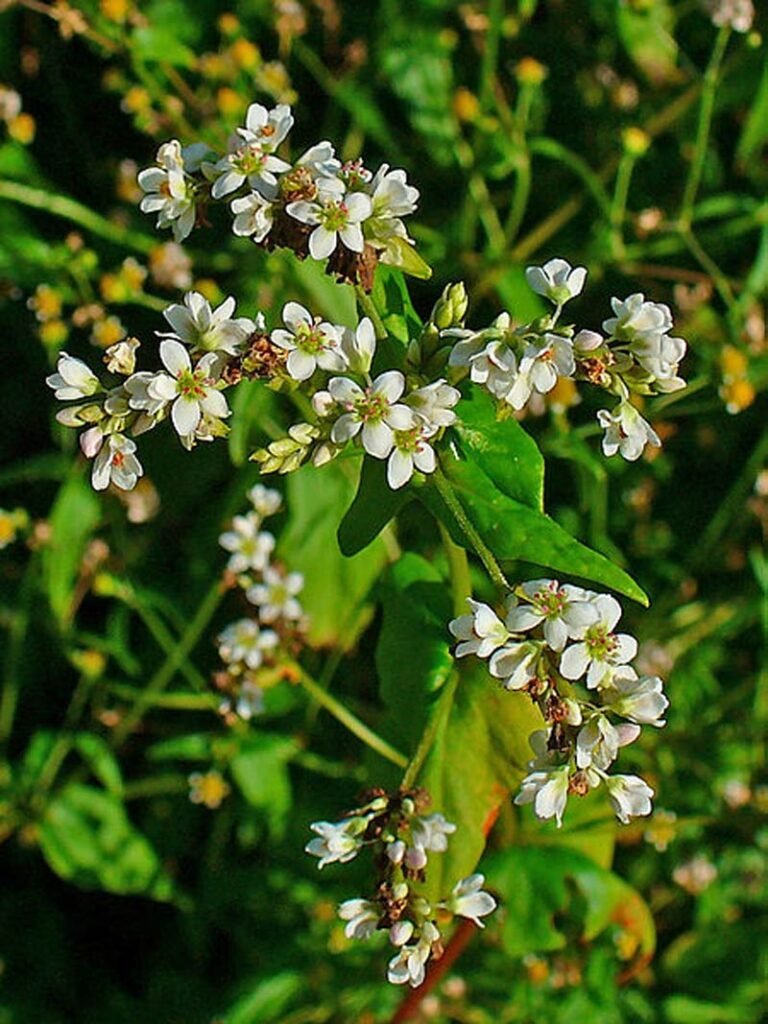
Botanical Name: Fagopyrum Esculentum
Kingdom: Plantae
Division: Magnoliophyta
Class: Magnoliopsida
Order: Caryophyllales
Family: Polygonaceae
Genus: Fagopyrum
Species: F. esculentum
Popular Name: Buckwheat
Parts Used: Buckwheat, Bucwheat Hulls
Habitat: Native to Central and Northern Asia
Description
The name ‘buckwheat’ or “beech wheat” comes from the triangular seeds of the herb, which resemble the much larger seeds of the beechnut from the beech tree. Buckwheat is a short season crop that does well in poor acidic soils, but the soil must be well drained. Too much fertilizer, especially nitrogen, will greatly reduce yields. In hot climates, it can be grown only by sowing late, so that it may bloom in cooler weather. Buckwheat is sometimes used as a green manure, as a plant for erosion control, or as wildlife cover and feed.
Plant Chemicals
Salicylaldehyde (2-hydroxybenzaldehyde) is a characteristic component of buckwheat aroma. 2, 5-dimethyl-4-hydroxy-3(2H)-furanone, (E,E)-2,4-decadienal, phenylacetaldehyde, 2-methoxy-4-vinylphenol, hexanal and (E)-2-nonenal, decanal are other compounds that account for the aroma of the herb. Starch, proteins, minerals and antioxidants are the other compounds found in it.
Uses and Benefits of Buckwheat
- Buckwheat is high in fibre, as 1 cup of cooked buckwheat groats contains over 4 grams of dietary fibre, which is essential to keep the bowels moving.
- The protein in buckwheat is the best-known source of high biological value proteins in the plant kingdom. It contains the eight essential amino acids (eight proteins that body cannot manufacture), making it closer to being a “complete” protein.
- Buckwheat is also a good oil source of an essential fatty acid, Alpha-Linolenic Acid, that is important for the body to stay healthy. It is also high in lysine.
- It contains 75% complex carbohydrates, which satisfy our appetite and fuel our cells. It is also good for the people who struggle with wheat allergies and gluten intolerance.
- Owing to the quantity of magnesium contained in buckwheat, it has a relaxing effect over blood vessels, helps improve circulation, decreases blood pressure and reduces cholesterol.
- As it contains plenty of vitamins with B complex, buckwheat is recommended in case of liver disorders and illnesses where it is advisable to restrict the quantity of sugary substances consumed each day.
- Due to a good mineral list (phosphorus, magnesium, iron, zinc, copper and manganese) and high flavonoid content, it’s traditionally used to fix low haemoglobin and frequent colds and flu.
- Buckwheat helps lower glucose levels and is beneficial for managing diabetes.
- Due to the presence of inosit, it is regarded as a well-balanced and low-calorie diet that helps reduce fat accumulation and adjusts metabolism as well as lipo-soluble vitamins.
- Buckwheat contains rutin, a medicinal chemical that strengthens capillary walls, reduces haemorrhaging in people with high blood pressure, prevents heart attack and increases microcirculation in people with chronic venous insufficiency.
- It also helps the liver process hormones, medicines, and glucoses, with a protective hepatic effect.
- Buckwheat has phytonutrient plant lignans, which are converted into mammalian lignans by friendly flora in our intestines, including one called enterolactone that is thought to protect against breast cancer as well as against other forms of cancer dependent on hormones and even heart disease.
- Buckwheat is an antidote for x-ray irradiations or other forms of irradiation, as it contains anti-oxidants.
- Eating foods high in insoluble fiber, such as buckwheat, can help women avoid gallstones. It is also protective against childhood asthma.
- Eating a serving of whole grains, such as buckwheat, at least 6 times a week is good for postmenopausal women with high cholesterol, high blood pressure, post menopausal breast cancer or other signs of cardiovascular disease.

